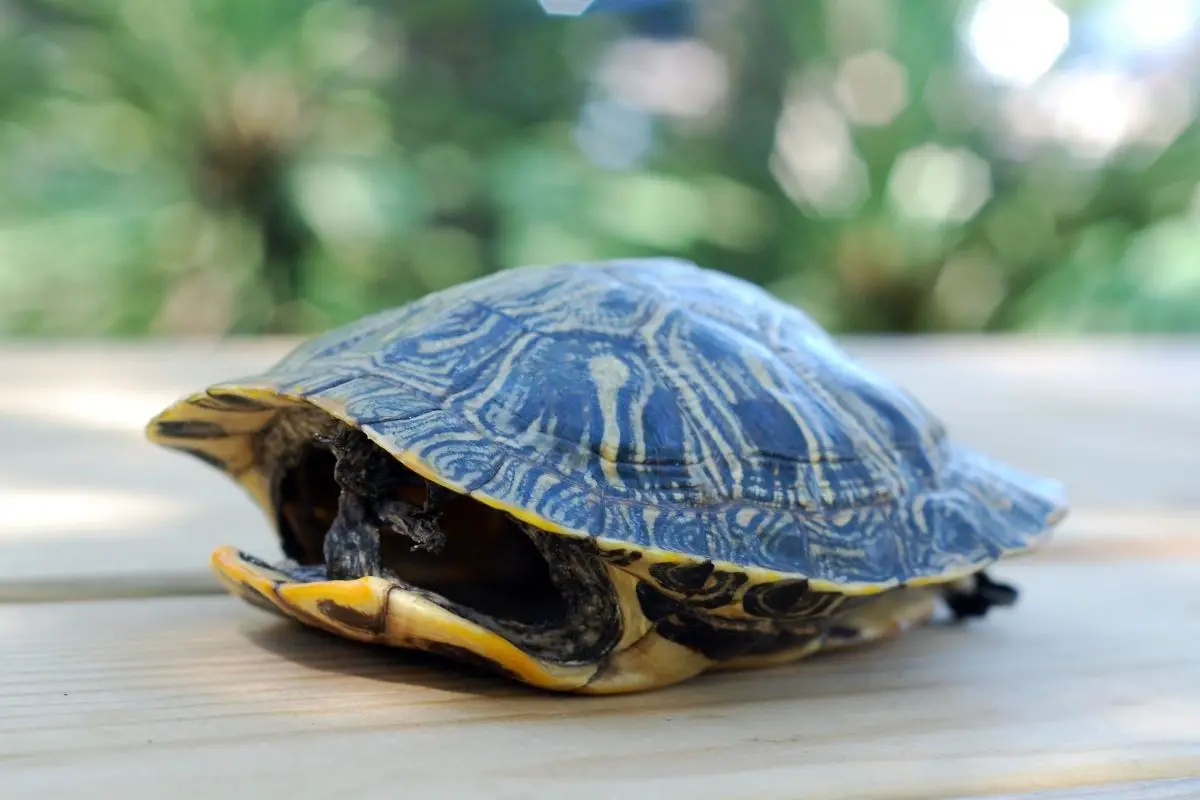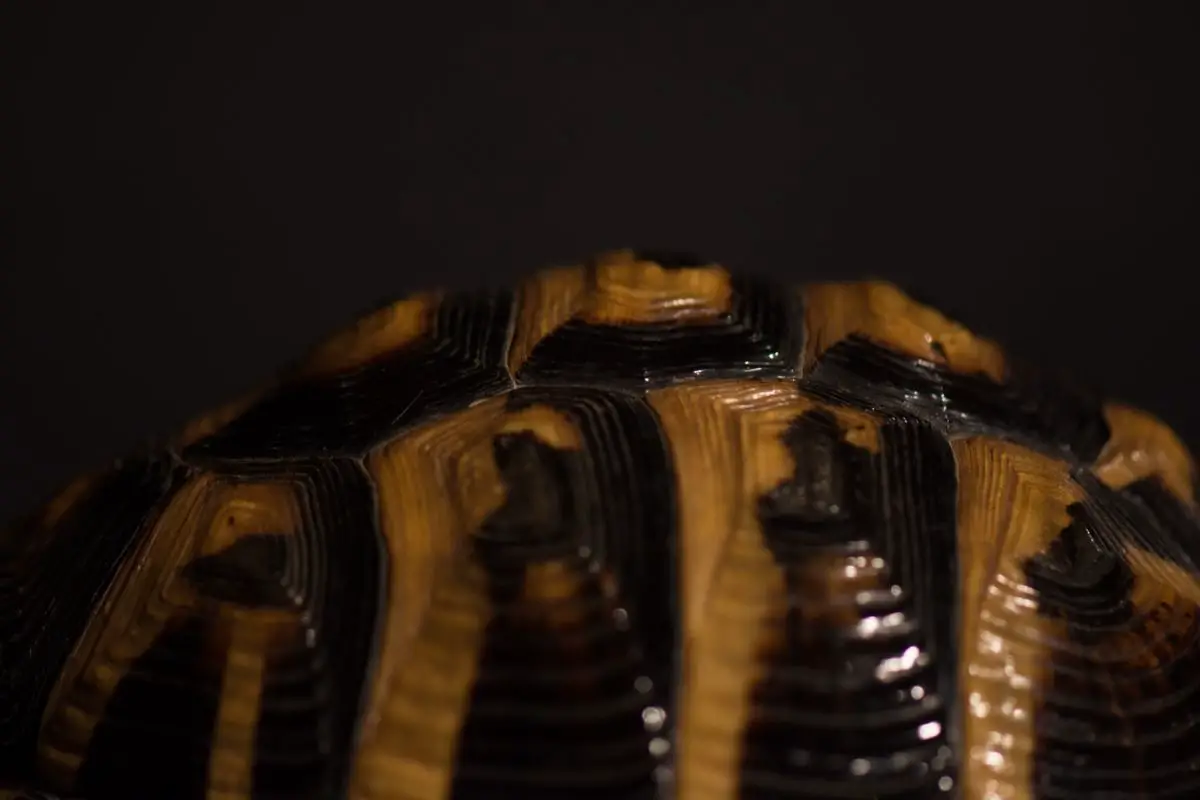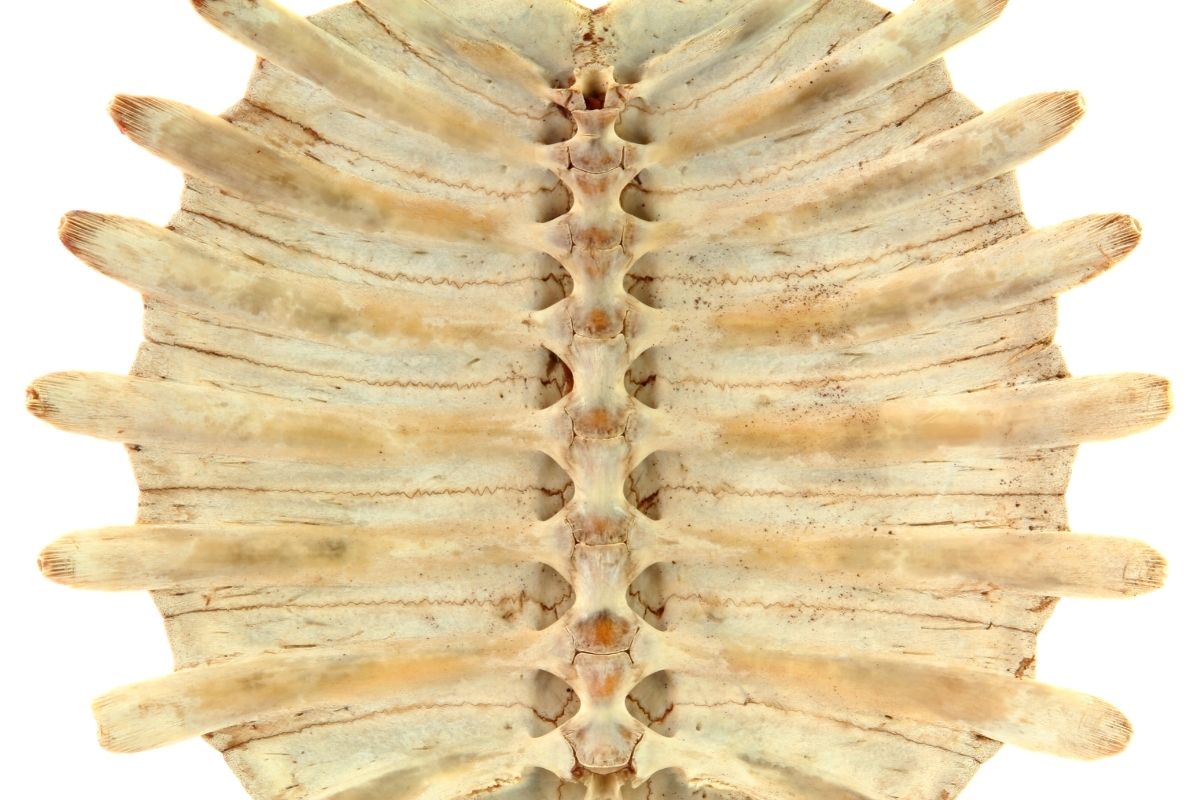Children’s cartoons would have you believe that a turtle’s shell serves as the animal’s “home” and that it is completely free to depart at any time.
However, this is very far from the truth. Because the turtle’s shell is composed of skin, bones, collagen, and keratin, the turtle and its shell are considered to be one body.
A turtle will never be able to escape its shell since the shell itself holds everything in place, including the turtle’s entire body. If you’ve ever been interested in what goes on inside a turtle’s shell, you’ve arrived at the perfect article.
What exactly is included within a turtle shell and the components that makeup the shell will be discussed below.
Get ready to learn a great deal about turtles!

Turtle Shells – What’s Inside?
Internal organs such as the lungs and heart of the turtle are located within the shell. The turtle’s reproductive organs are also ticked away in there as well.
But that’s not all; the shell is jam-packed with all the organs turtles need to survive. From one end of the turtle to the other, here is what else is inside the shell:
- The Esophagus – is the tube that connects the mouth and stomach.
- The Trachea – is the tortoise’s wind/airway pipe.
- The Lungs – like humans, turtles also have two lungs for breathing.
- The Heart – is responsible for the circulatory system of the body.
- The Stomach – is a component of the turtle’s digestive tract, lying between the esophagus and the intestines.
- The Intestine – a digestive organ
- The Pancreas is a gland that makes digestive enzymes.
- The Liver – this organ makes bile
- The Bladder is where pee is stored.
- The Rectum is the digestive tract’s last segment.
- The Anus – is the exit of the digestive system
Can A Turtle Live Without Its Shell?
As you can see above, the shell of the turtle houses all of the vital internal organs of the animal. Because of this, it would be impossible for a turtle to be able to survive without its shell.
The shell holds the whole turtle’s body together as well, and as you will see further down, it is fused to the turtle’s bones, including its ribs and spine, so it is impossible for a turtle to be shell-less anyway.
What Is The Shell Made Of?

A turtle’s shell is made of three distinct parts. They are:
- The Carapace – this is the top of the shell and probably the part you think of when you imagine a turtle-domed shell
- The Plastron – if you flipped a turtle over, you’d see a flat piece of bone at the bottom of the animal. This is the plastron
- The Bridge – while this is part of the plastron, it can be considered its own part of the shell. This is what holds the top carapace to the bottom plastron together
Here is a more in-depth look at these parts of the turtle’s shell.
The Carapace
The carapace is the top part of the shell that kind of resembles a dome. This convex section of the shell is made of ossified rib and dermal bones that have fused. The spine and the ribs also fuse and then fuse to the dermal bone during the ossification process.
Following that is skin. This epidermis is then covered with scutes, which are composed of keratin. Scutes shield the bone plates from cuts, scrapes, and bruising.
Certain turtles, such as map turtles and a variety of sea turtles, have a keel along the length of their shell. Keels are commonly found on the shells of aquatic turtles.
The turtle’s shell is made up of multiple bones, including pygal plates, proneural plates, suprapygal plates, peripheral plates, and neural plates.
On top of these bony plates are scutes, also known as epidermal laminae. Because the scutes are more apparent, they are critical for turtle identification, as each turtle species has unique scutes to them.
Three types of scutes can be looked at to identify where a turtle is from and what species it is. They are:
- Coastal scutes (lateral scutes)
- marginal scutes
- vertebral scutes (precentral scutes and central scutes).
Bones In The Carapace
These components unite to form the skeleton of the carapace.
- Proneural plate – This bone is placed closest to the skull in the shell’s center front position. Each turtle has a single proneural plate on its shell.
- Neural plates – are found at the front of the turtle’s shell. These are located just behind the proneural plate. They make their way along the shell’s center toward the tail. Turtles have an average of eight neural plates.
- Suprapygal plates – These bones (typically two) are found directly below the neural plates at the shell’s end.
- Pygal plate – this is positioned near the tail end of the shell. Each turtle shell contains one pygal plate.
- Pleural plates – On both sides of the neural plates are the pleural plates. They are quite long and wide. The majority of turtles have between sixteen and eighteen pleural plates.
- Peripheral plates – Peripheral plates are located on the edge/periphery of the carapace. Certain turtles can have up to 22 plates on their periphery. The first peripheral bone connects to the proneural plate. The peripheral plates then wrap around the pygal plate’s edge. This happens on both the inside and external surfaces of the shell.
Scutes
We have mentioned scutes quite a bit now, so here is a bit more information on this important part of a turtle’s shell.
Scutes, the outermost layer of the shell, are made of keratin, the same material that makes human nails. Because of this, the scutes are strong and pliable.
Scutes protect the bony shell. The scutes of the land tortoise increase as the turtle ages, forming more rings. Counting the scute rings is one way to determine the age of a turtle.
In the water, turtles shed their old scutes. When a turtle sheds its skin, it seems as though its shell is peeling away. Turtles will do this if they have recently been attacked by a predator and their shell has got a bit damaged. Once the old scutes have been shredded away, new ones will grow.
Not all turtles have scutes. Certain species’ shells are covered in skin. These are known as softshell turtles. Softshell turtles come in two varieties: leatherback sea turtles and freshwater softshell turtles.
The Carapace Scutes
Above the bony plates are the scutes. The scutes are the visible portion of the shell. Between 11 and 13, main scutes are found on the majority of turtles.
These are the ones that are used to both identify the species of turtle and also show the age of the animal.
However, there are about 24 little scutes, termed marginal scutes, around the carapace’s border. Marginal scutes are named for their placement around the carapace’s margins.
Here are some other scutes on the turtle’s carapace.
- Nuchal scute – is the scute just beneath the turtle’s skull.
- Central scutes- this scute is found at the center of the shell. It is often the outermost shell. Typically, just one central scute exists per turtle
- Precentral scutes – These are the scutes that follow the central scute. Four precentral scutes are typically located around the middle of the shell. The precentral and central scutes are also called the vertebral scutes.
- Lateral scutes – on both sides, these scutes run parallel to the precentral and central scutes. Typically, the vertebrae have around eight lateral scutes, four on each side. The term “coastal” refers to lateral scutes as well
- Marginal scutes – these are extremely little scutes that run along the margin/edge of the carapace.
In total, you can expect a turtle to have thirteen scutes, though this does not include the many smaller marginal scutes that you can find along the edge of the turtle.
The Plastron

The plastron is the flat underside section of the turtle’s shell. In addition to the bridge, the plastron contains the anterior and posterior bridge struts. The plastron is made of around nine bones, of which two are epiplastra.
Plastron Bones
Like with the carapace, the plastron portion of the shell is made up of many different bones that have fused. They are:
- The epiplastra – each turtle is equipped with two epiplastra. These are located on the front of the plastron. The epiplastra on the left and right are found next to each other.
- The entoplastron – Just under the epiplastra lies the entoplastron. two hyoplastra and Two epiplastra surround this bone. The hyoplastra are placed just under the epiplastra.
- The hyoplastra – on either side of the epiplastra are two hyoplastra. Two other hyoplasms are discovered beneath. There are a total of four hyoplasms.
- The xiphi plastra – There are two xiphilastra beneath the hyoplastra.
- The bridge – this part connects the bottom plastron to the top carapace.
Plastron Scutes
As with the carapace, scutes are affixed to bony plates. Six separate types of plastron scutes exist. They are:
- Gular Scutes – these scutes run parallel to the turtle’s skull.
- Femoral, Abdominal, Pectoral, and Humeral Scutes – Following the gular scutes are a pair of humeral scutes, a pair of pectoral scutes, a pair of abdominal scutes, and finally, a pair of femoral scutes. Certain turtles, like musk turtles, have triangular-shaped pectoral scutes, while other species, like mud turtles, have squarish-shaped pectoral scutes.
- Anal Scutes – these are the final scutes pair found on the plastron
Summary
There are a variety of different sizes, shapes, textures, and colors of shells available for turtles and tortoises to inhabit.
Their shells serve a number of functions, including shielding them from predators and the environment, but they are also an intrinsic component of their body.
To minimize shell disorders such as shell pyramiding, which may be deadly to a turtle if not properly cared for, the correct diet for a turtle or tortoise kept as a pet is necessary.
Frequently Asked Questions
The turtle shell is a fascinating and perplexing part of the animal’s body that has fascinated and confused everyone, even biologists, for generations.
We now have a more complete understanding of the turtle shell. Here are some interesting facts about turtles and answers to frequently asked questions.
Can Turtles Survive Being Shell-Less?
Even though a turtle cannot live without its shell, it may survive severe shell damage. Turtles can heal minor shell damage and injuries such as shell fractures, bites, or smaller wounds that may have been caused by an attack.
If your pet turtle has a damaged shell, the best thing you can do is take it to a vet straight away.
What Color Are Turtle Shells?
Turtle shells come in a variety of colors depending on the species. There are a few common colors though, such as black, brown, tan, and olive green.
Olive-green or brown carapaces, for example, are distinctive of turtle species such as the slider.
Typically, the plastron is a more brightly colored part of the turtle’s shell and can sometimes be what the turtle is named after.
As an example, the plastron of the yellow-bellied slider is yellow, but the plastron of the red-bellied cooter is red.
Is A Turtle Shell Very Hard?
Turtle shells are incredibly strong and protect the turtle. They may, however, not be as tough as you assume. The leathery shells of softshell turtles are extraordinarily soft to the touch. Softshell turtle species, though, are fairly rare.
Even turtles with hard shells have soft parts. This is the collagen and the scutes of the shell.
How Strong Are Turtle Shells?
Not only is a turtle shell highly durable, but it also serves as protection for the turtle. Collagen-coated bone plates and scutes from the shell. These act as shock absorbers, helping to protect the bone plates beneath.
Despite how tough turtle shells are, it may surprise you that smaller animals, such as cats and dogs, can attack and hurt a turtle.
Cats can potentially cause irreversible damage to small and medium-sized turtles. Dogs are particularly prone to attack turtles and are capable of causing major injury or death.
Does The Shell Grow?
The shell, like any other organ of the body, grows alongside the turtle. The bones and scutes both develop in size. Aquatic turtles outgrow their scutes.
These are then scraped away and replaced with new scutes. As turtles grow in size, rings are added to their scutes.
Is The Shell Part Of The Turtle’s Body?
Yes, the shell is part of the turtle’s body and a very vital one at that. The shell contains both the backbone and ribs.
Can The Shells Bleed?
When properly broken, a turtle shell, like any other biological component, will bleed. On the other hand, the shell is far stronger and can withstand much more force than other body components such as the head, tail, or limbs.
Due to their slow speed, turtles cannot run away from danger, so they need their shells to be very strong to protect them from attacks.
Summary
There are a variety of different sizes, shapes, textures, and colors of shells available for turtles and tortoises to inhabit.
Their shells serve several functions, including shielding them from predators and the environment, but they are also an intrinsic component of their bodies.
To minimize shell disorders such as shell pyramiding, which may be deadly to a turtle if not properly cared for, the correct diet for a turtle or tortoise kept as a pet is necessary.
